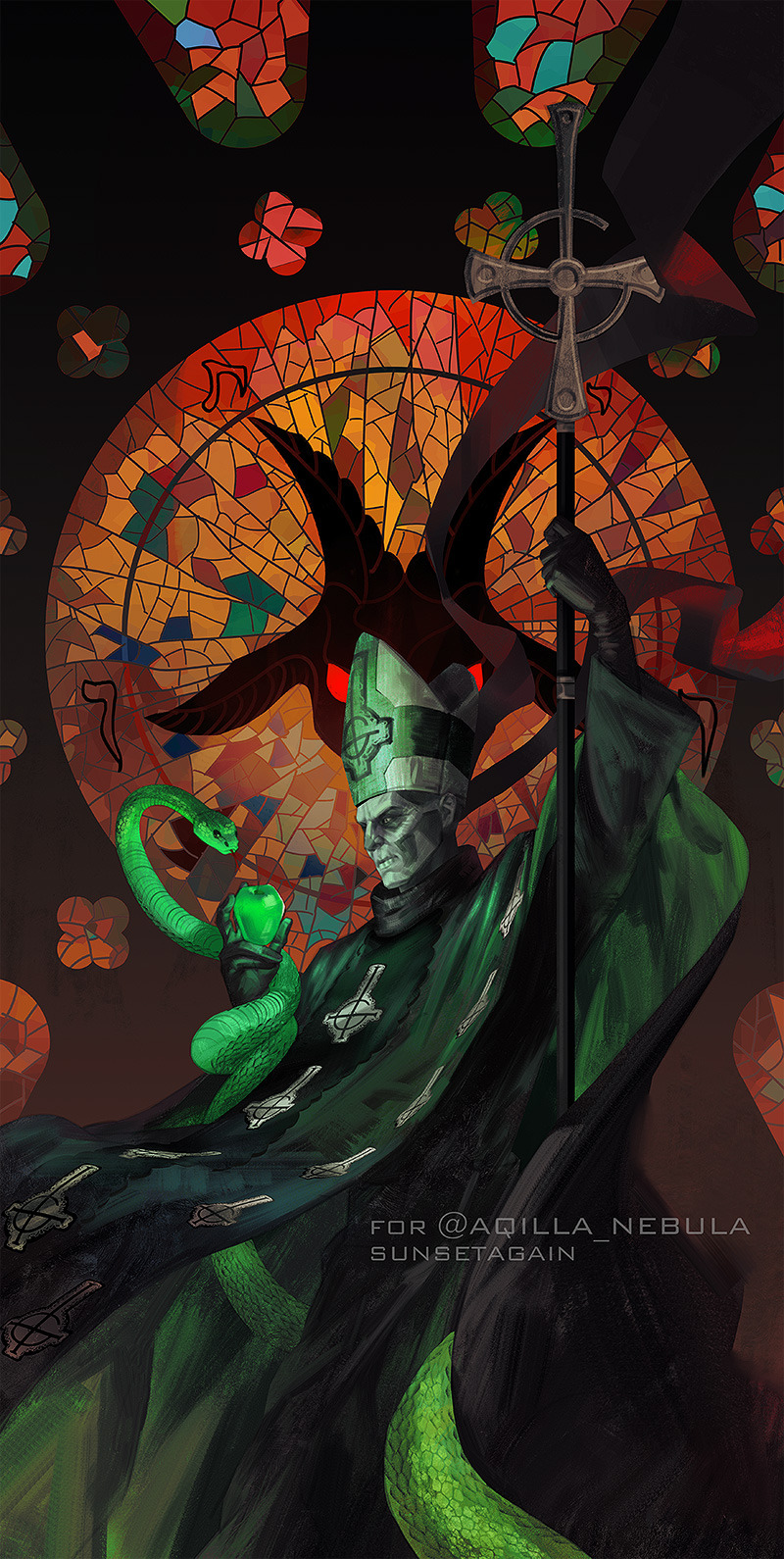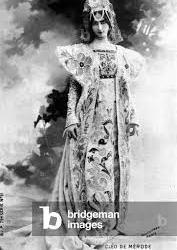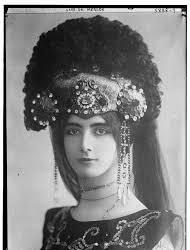Text
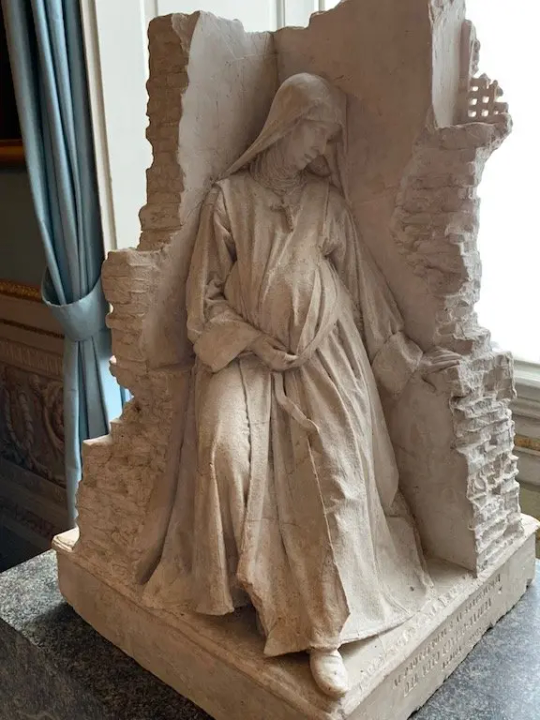
"Voto contro Natura" (Vote against nature) . Made between 1860 and 1870, it is the anti-clerical denunciation of the terrible practice of the forced monacation. The subject is a woman in religious clothes and in advanced pregnancy, hidden in a corner in a deep state of despair, almost as if it were a prisoner.
There is a dedication engraved in the base of sculpture: '' to the protectors and supporters of the vote against Natura '', a real scream against those who favored the practice of the forced monacation of pregnant girls. The environment around the woman is unequivocally miserable, squalid, to underline the sadness and impotence of the subject.
Salvatore Grita wanted to demonstrate his contempt and his pain against the practice to intern in the convent unmarried mothers, perhaps also because he himself, son of a very young mother girl, grew up in an orphanage entrusted to the cloistered nuns, who evidently not They left him a great memory. So the story was deeply felt for him.
#Sculpture#anticlericalism#forced monacation#pregnant mother#Italy#Sicily#Salvatore Grita#unmarried mother#catholic convent#child abuse#nuns
0 notes
Text

Michelangelo carved a number of works in Florence during his time with the Medici, but in the 1490s he left Florence and briefly went to Venice, Bologna, and then to Rome, where he lived from 1496-1501. In 1497, a cardinal named Jean de Billheres commissioned Michelangelo to create a work of sculpture to go into a side chapel at Old St. Peter’s Basilica in Rome. The resulting work – the Pieta – would be so successful that it helped launch Michelangelo’s career unlike any previous work he had done.
Michelangelo claimed that the block of Carrara marble he used to work on this was the most “perfect” block he ever used, and he would go on to polish and refine this work more than any other statue he created.
The scene of the Pieta shows the Virgin Mary holding the dead body of Christ after his crucifixion, death, and removal from the cross, but before he was placed in the tomb. This is one of the key events from the life of the Virgin.
These two figures are carved so as to appear in a unified composition which forms the shape of a pyramid, something that other Renaissance artists (e.g. Leonardo) also favored.
#Michelangelo#Pietà#Rome#Renaissance#Holy Mother#Jesus#Death#Saint Peter's Cathedral#Virgin Mary#Marble Sculpture#Carrara marble
0 notes
Text
Sister Imperator, probably: Fuck you, my child is completely fine!
The child in question:

622 notes
·
View notes
Text

"She had seen that the finger of Death was upon her bosom—that, like the Ephemeron, she had been made perfect in loveliness only to die; but the terrors of the grave to her lay solely in a consideration which she revealed to me, one evening at twilight, by the banks of the River of Silence."
Edgar Allan Poe (Eleonora)
Isabella Casati newsstand, sculptor Enrico Butti
Known as "The Dying", the bronze sculpture was created between 1890 and 1891 by the famous Varese sculptor Enrico Butti on commission from Count Gian Luigi Casati Brioschi, widower of the late Isabella, who died in childbirth in 1889 at just twenty-four years of age . The young woman, descendant of the noble Airoldi family of Robbiate, is portrayed in the moment of her passing, lying lifeless on her deathbed, covered with a cloth that leaves her breast exposed, on which a crucifix is placed. Her face is turned to the side of her, her eyes squeezed shut and strands of hair scattered across her pillow. The expression is relaxed and serene, of that peace that mysteriously comes after death. In the panel behind her, made of Simona della Valcamonica stone, there is a bronze disc in which angelic hosts are depicted who ideally accompany the young woman into the afterlife. The delicate sensuality that the sculpture transmits is truly touching, so much so that it makes it one of the most poignant and admired works of the Monumentale in Milan. A work suspended between realism and symbolism, it provoked more than one criticism at the time of its inauguration, as bare breasts were considered inappropriate for a funeral context.
#Isabella Casati grave#Monumental cemetery (Milan)#Milan#Italy#The Dying#Enrico Butti#Deathbed#early 1900s#bronze sculpture#maternal death
1 note
·
View note
Text
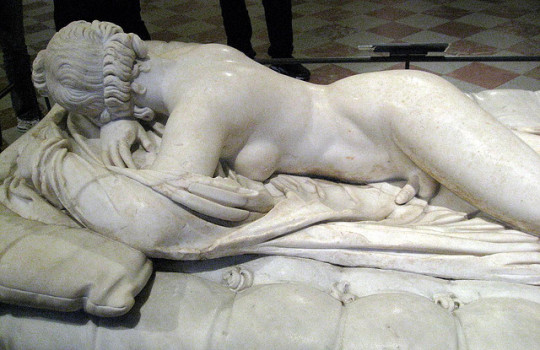
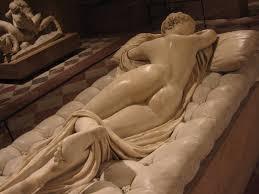

According to the Latin poet Ovid, Hermaphroditus was an extraordinarily beautiful boy who was made androgynous following his union with a nymph. Son of Hermes and the goddess of love, Aphrodite, in Greco-Roman art he is often depicted as a girl endowed with male attributes, a symbol of fertility given that, possessing the characteristics of both genders, Hermaphroditus had the ability to conceive and fertilize. For this reason, in classical antiquity the mythological character was associated with the institution of marriage to symbolize the sacred bond of man and woman. The story of Hermaphroditus begins precisely because of an overwhelming love passion. The nymph Salmace fell in love with the young man to the point of begging her gods to bind her to him forever, without there being the possibility of ever being separated: so the two were fused into a single body, half male and half female . Since both parents belong to the sphere of eroticism and fertility, Hermaphroditus is often identified with Aphrodite, the male equivalent of Aphrodite, and considered, according to some myths, as the brother of Priapus, a deity known for his perennial state of sexual excitement. The oldest traces of the cult of this young god are found on the island of Cyprus where, according to the testimony of Macrobius, a statue of Aphrodite was venerated, but with a male appearance and a beard: during the cult the participants in the rites, women and men, they used to exchange clothes, giving rise to a sort of early transvestism.
1 note
·
View note
Text

The anniversary of the liberation of Italy, also known as Liberation Day (or simply 25 April), is a national holiday of the Italian Republic, which is celebrated every 25 April to commemorate the liberation of Italy from Nazi occupation and fascist regime, crowning Italian resistance to Nazi-fascism.
"Bella ciao" (Goodbye beautiful) is an Italian song dedicated to the partisans of Italy who fought against the invading forces of Nazi Germany and the fascist collaborationists of the Italian Social Republic between 1943 and 1945 during the Italian resistance and the liberation of Italy.
In the song, a reference is made to the "partisan flower" which would forever remember the fighters who died in the Italian mountains and valleys for the liberation. This flower is popularly identified as the very common field poppy, with a bright red color that recalls the blood shed by the partisans.
Years later, Fabrizio de Andrè, one of the most important Italian singer-songwriters, in the song "La Guerra di Piero" (one of the most popular Italian anti-militarist songs) recalls the "thousand red poppies that watch over you from the shadow of the ditches", speaking of a soldier who died in one of the many Italian wars.
The thousand blood red poppies are ready every year to remind us how much our fragile freedom has cost…
#25 april#thousand red poppies#liberation#nazi-fascism#Fabrizio de Andrè#Bella Ciao#Italia#Italy#Partisans#Resistence#La guerra di Piero#Piter's war
1 note
·
View note
Text
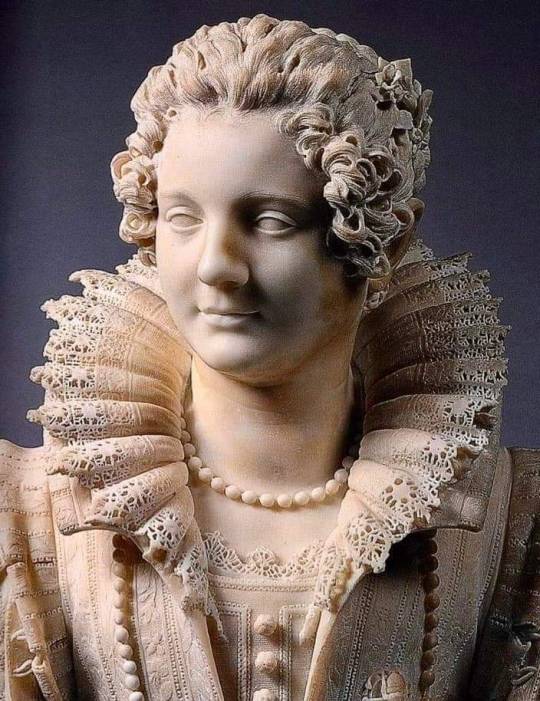
Bust of Maria Barberini Duglioli (1626-27) by the Italian sculptor Giuliano Finelli (1601-1653). Everything you see in the photo is made of marble including the delicate lace collar, the flower in her curly hair and her strings of pearls.
40 notes
·
View notes
Text

Osiris, one of the most important gods of ancient Egypt. The origin of Osiris is obscure; he was a local god of Busiris, in Lower Egypt, and may have been a personification of chthonic (underworld) fertility. By about 2400 BCE, however, Osiris clearly played a double role: he was both a god of fertility and the embodiment of the dead and resurrected king. This dual role was in turn combined with the Egyptian concept of divine kingship: the king at death became Osiris, god of the underworld; and the dead king’s son, the living king, was identified with Horus, a god of the sky. Osiris and Horus were thus father and son. The goddess Isis was the mother of the king and was thus the mother of Horus and consort of Osiris. The god Seth was considered the murderer of Osiris and adversary of Horus.
According to the form of the myth reported by the Greek author Plutarch, Osiris was slain or drowned by Seth, who tore the corpse into 14 pieces and flung them over Egypt. Eventually, Isis and her sister Nephthys found and buried all the pieces, except the phallus, thereby giving new life to Osiris, who thenceforth remained in the underworld as ruler and judge. His son Horus successfully fought against Seth, avenging Osiris and becoming the new king of Egypt.
Osiris was not only ruler of the dead but also the power that granted all life from the underworld, from sprouting vegetation to the annual flood of the Nile River. From about 2000 BCE onward it was believed that every man, not just the deceased kings, became associated with Osiris at death. This identification with Osiris, however, did not imply resurrection, for even Osiris did not rise from the dead. Instead, it signified the renewal of life both in the next world and through one’s descendants on Earth. In this universalized form Osiris’s cult spread throughout Egypt, often joining with the cults of local fertility and underworld deities.
The idea that rebirth in the next life could be gained by following Osiris was maintained through certain cult forms. In the Middle Kingdom (1938–c. 1630 BCE) the god’s festivals consisted of processions and nocturnal rites and were celebrated at the temple of Abydos, where Osiris had assimilated the very ancient god of the dead, Khenty-Imentiu. This name, meaning “Foremost of the Westerners,” was adopted by Osiris as an epithet. Because the festivals took place in the open, public participation was permitted, and by the early 2nd millennium BCE it had become fashionable to be buried along the processional road at Abydos or to erect a cenotaph there as a representative of the dead.
0 notes
Text

Come together, together as one.
Come together, for Lucifer's son.
0 notes
Text

“Nel fosso sù”, diss’ el, “de’ Malebranche,
là dove bolle la tenace pece,
non era ancora giunto Michel Zanche,
che questi lasciò il diavolo in sua vece
nel corpo suo.”
(Inf. 33.142-46)
“There in the Malebranche’s ditch above,
where sticky pitch boils up, Michele Zanche
had still not come,” he said to me,
“when this one left a devil in his stead
inside his body.”
2 notes
·
View notes
Text




WHY is this so erotic it’s Michael banishing Lucifer to Hell from late 19th century Italy. I am chomping at the bit just absolutely flabbergasted by this statue. It’s SO bisexual [heart eyes]
15 notes
·
View notes
Text
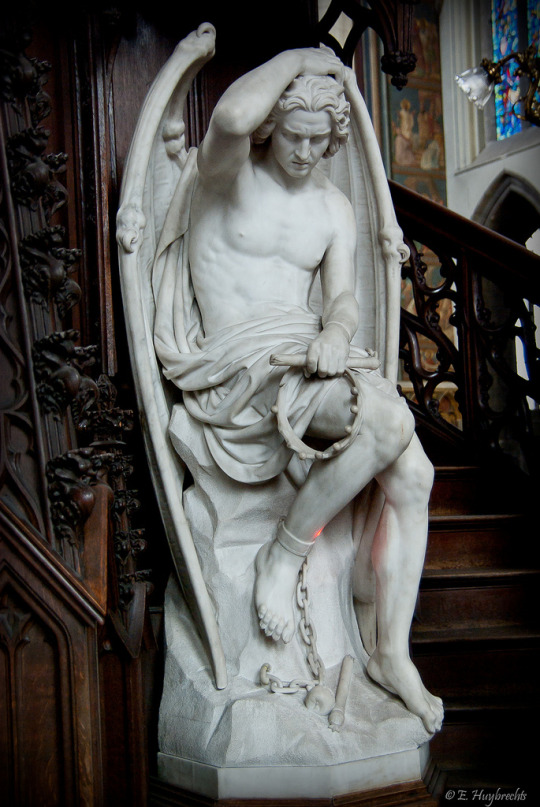
5 notes
·
View notes
Text

Lina Cavalieri
1 note
·
View note
Text
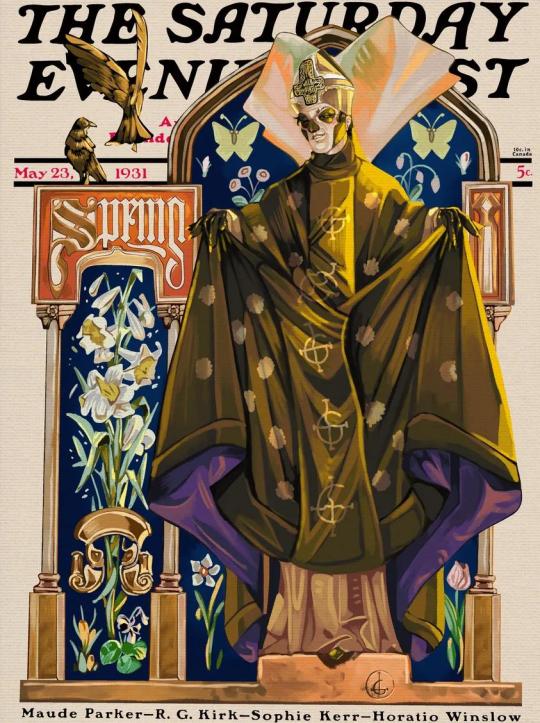
Queen of spring by leyendecker but terzo is my queen 🙏
931 notes
·
View notes
